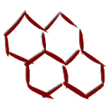|
|
 January 8th, 2013 Congratulations to Leonardo, Andrea and North for their paper, “Quantum and classical confinement of resonant states in a trilayer graphene Fabry-Pérot interferometer” being published in Nature Communications!
Nature Communications 3, Article number: 1239 doi:10.1038/ncomms2243
Abstract
The advent of few-layer graphene has given rise to a new family of two-dimensional systems with emergent electronic properties governed by relativistic quantum mechanics. The multiple carbon sublattices endow the electronic wavefunctions with pseudospin, a lattice analogue of the relativistic electron spin, whereas the multilayer structure leads to electric-field-effect tunable electronic bands. Here we use these properties to realize giant conductance oscillations in ballistic trilayer graphene Fabry-Pérot interferometers, which result from phase coherent transport through resonant bound states beneath an electrostatic barrier. We confine these states by selectively decoupling them from the leads, resulting in transport via non-resonant states and suppression of the giant oscillations. The confinement is achieved both classically, by manipulating quasiparticle momenta with a magnetic field, and quantum mechanically, by locally varying the pseudospin character of the carrier wavefunctions. Our results illustrate the unique potential of trilayer graphene as a versatile platform for electron optics and pseudospintronics.
 July 23rd, 2012 Professor Jarillo-Herrero was one of five MIT faculty members named by President Barack Obama today as a recipient of a Presidential Early Career Award for Scientists and Engineers (PECASE), the highest honor bestowed by the U.S. government on science and engineering professionals in the early stages of their independent research careers.
Read more at MIT News: Five MIT researchers win presidential early career honors.
 July 22nd, 2012 A collaboration work between our group and Michael Strano’s group at MIT has been recently accepted to Nature Chemistry! Preprint is available at arXiv:1207.3369.
Chemical reactivity imprint lithography on graphene: Controlling the substrate influence on electron transfer reactions
Qing Hua Wang, Zhong Jin, Ki Kang Kim, Andrew J. Hilmer, Geraldine L.C. Paulus, Chih-Jen Shih, Moon-Ho Ham, Javier D. Sanchez-Yamagishi, Kenji Watanabe, Takashi Taniguchi, Jing Kong, Pablo Jarillo-Herrero, Michael S. Strano
The chemical functionalization of graphene enables control over electronic properties and sensor recognition sites. However, its study is confounded by an unusually strong influence of the underlying substrate. In this paper, we show a stark difference in the rate of electron transfer chemistry with aryl diazonium salts on monolayer graphene supported on a broad range of substrates. Reactions proceed rapidly when graphene is on SiO_2 and Al_2O_3 (sapphire), but negligibly on alkyl-terminated and hexagonal boron nitride (hBN) surfaces. The effect is contrary to expectations based on doping levels and can instead be described using a reactivity model accounting for substrate-induced electron-hole puddles in graphene. Raman spectroscopic mapping is used to characterize the effect of the substrates on graphene. Reactivity imprint lithography (RIL) is demonstrated as a technique for spatially patterning chemical groups on graphene by patterning the underlying substrate, and is applied to the covalent tethering of proteins on graphene.
 May 24th, 2012 Congratulations to 2nd year graduate student Valla Fatemi for receiving a National Defense Science and Engineering Graduate Fellowship!
 April 10th, 2012 Undergraduate researcher Nityan Nair is one of two MIT students to be named a Goldwater Scholar this year. Nityan currently works with the graphene optoelectronics team. More details at MIT News
 January 30th, 2012 Congratulations to Javier and Thiti for their publication, Quantum Hall Effect, Screening and Layer-Polarized Insulating States in Twisted Bilayer Graphene, being accepted to Physical Review Letters.
The paper is currently available on arxiv:
http://arxiv.org/abs/1110.4628
 January 5th, 2012 
Congratulations to Javier and our collaborators at Brian Leroy’s group at University of Arizona for their new publication in Physical Review Letters.
Long wavelength local density of states oscillations near graphene step edges
Jiamin Xue, Javier Sanchez-Yamagishi, K. Watanabe, T. Taniguchi, Pablo Jarillo-Herrero, Brian J. LeRoy
Phys. Rev. Lett., 108, 016801 (2012)
Using scanning tunneling microscopy and spectroscopy, we have studied the local density of states (LDOS) of graphene over step edges in boron nitride. Long-wavelength oscillations in the LDOS are observed with maxima parallel to the step edge. Their wavelength and amplitude are controlled by the energy of the quasiparticles allowing a direct probe of the graphene dispersion relation. We also observe a faster decay of the LDOS oscillations away from the step edge than in conventional metals. This is due to the chiral nature of the Dirac fermions in graphene.
 October 9th, 2011 Congratulations to Nathan, Qiong, Nityan, Thiti and Pablo for their paper, “Hot Carrier–Assisted Intrinsic Photoresponse in Graphene,” being published in Science.
Hot Carrier–Assisted Intrinsic Photoresponse in Graphene
Nathaniel M. Gabor, Justin C. W. Song, Qiong Ma, Nityan L. Nair, Thiti Taychatanapat, Kenji Watanabe, Takashi Taniguchi, Leonid S. Levitov, Pablo Jarillo-Herrero
Science Xpress 6 October 2011: 1211384
abstract:
We report on the intrinsic optoelectronic response of high-quality dual-gated monolayer and bilayer graphene p-n junction devices. Local laser excitation of wavelength λ = 850 nm at the p-n interface leads to striking six-fold photovoltage patterns as a function of bottom- and top-gate voltages. These patterns, together with the measured spatial and density dependence of the photoresponse, provide strong evidence that nonlocal hot-carrier transport, rather than the photovoltaic effect, dominates the intrinsic photoresponse in graphene. This regime, which features a long-lived and spatially distributed hot carrier population, may open the doorway for hot carrier–assisted thermoelectric technologies for efficient solar energy harvesting.
Press Coverage:
“Electrons heat up in graphene” from Physics World
“Graphene shows unusual thermoelectric response to light” from MIT News
 June 14th, 2011 Graduate student Thiti Taychatanapat’s results on quantum hall effect in trilayer graphene has been published in Nature Physics.
Quantum Hall effect and Landau-level crossing of Dirac fermions in trilayer graphene
Nature Physics (2011)
A Nature “News & Views” on Thiti’s paper can be found here: Graphene: Trilayers unravelled
 May 12th, 2011 Professor Jarillo-Herrero has been awarded the DOE Early Career Award for research in Quantum Transport in Topological Insulator Nanoelectronic Device.
DOE Office of Science Selects 65 Promising Researchers for Early Career Research Awards
Four from MIT receive DoE early career research grants
|
|


